I’m no racer. What I am is a cheapskate. That lifestyle isn’t compatible with pricey race mods, race-compound tires, and racing fees.
Gridding up may disagree with my beggar’s budget, but the occasional track day doesn’t. If I can spin some laps every other month, I’m a happy man. At that rate, my wallet isn’t too unhappy, either. Win-win (or win and less loss).
For such situations, a track-able bike is ideal. I don’t just want it to pass safety inspection. I want it to be track-ready out of the box. It shouldn’t require a laundry list of aftermarket parts to get there. Parts that could sacrifice the bike’s road-readiness in the process. That’s exactly what the Aprilia RS 457 sets out to be and that’s why I was giddy to get it on the circuit.
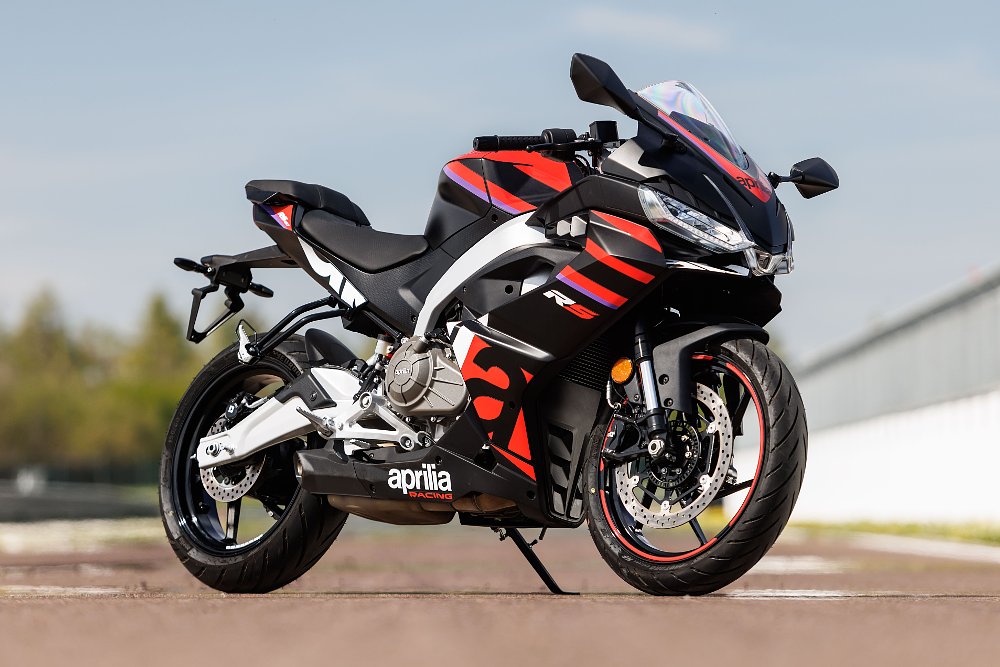
Divide and conquer
There’s an abundance of motorcycles at the RevZilla West garage. What we lack, sometimes, is the time to review them all. That was the case with the RS 457. So, Zack put the sport bike’s street cred to the test in the latest Daily Rider episode (watch below) and I evaluated it on track at Central California’s Buttonwillow Raceway.
For the uninitiated, Buttonwillow’s 3.1-mile circuit is a collection of 12 vastly different corners. From the Star Mazda hairpin to the Riverside sweeper, from Lost Hill/Phil Hill’s blind exit to the high-speed Esses, Buttonwillow’s diverse array of corners reveals the strengths and weaknesses of any bike, no matter the size. The RS 457 is no exception.
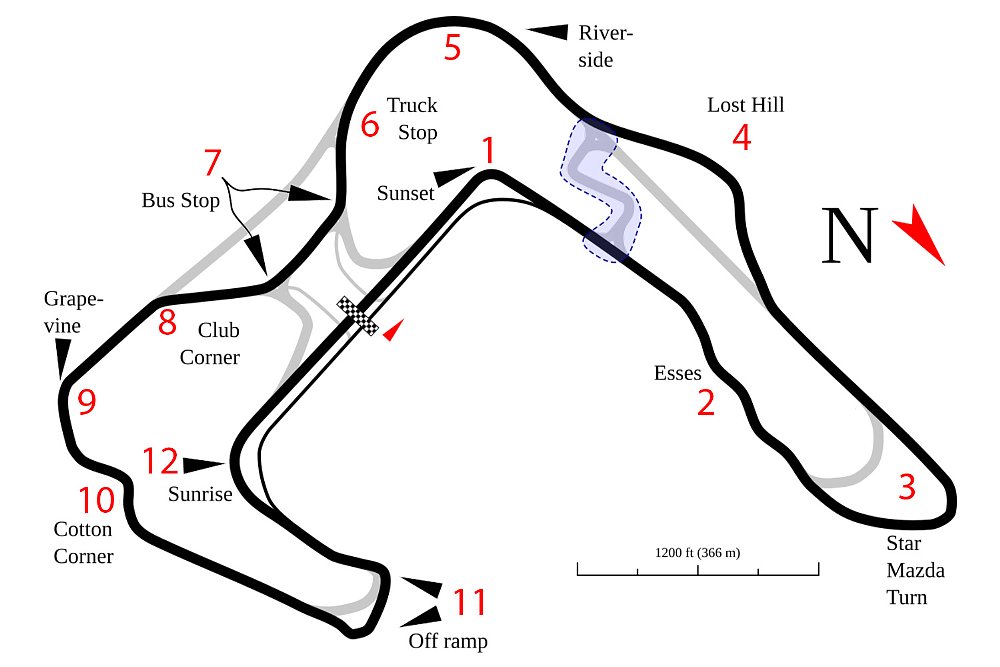
Torque on tap
The RS 457 is often mentioned in the same sentence with the Kawasaki Ninja 500 and CFMOTO 450SS. Most customers also cross-shop the Honda CBR500R, KTM RC 390, and Yamaha YZF-R3, but its closest competitors are the Ninja and SS. That’s partly because all three harness parallel twins around 450 cc in volume; 449 cc in the CFMOTO’s case and 451 cc for the Kawi. Of course, the Aprilia tops all three with its 457 cc capacity. The differences between the engines go beyond overall size, though.
The 450SS’s 72 mm bore is the largest among the group, but its 55.2 mm stroke is the shortest. The bike’s 50 horsepower (at 9,500 rpm) and 28.8 foot-pounds of torque (at 7,600 rpm) reflect those measurements. The Ninja only slightly diverges from that path with its 70 mm bore and 58.6mm stroke. Team Green claims 51 ponies (at 9,500 rpm) and 31.7 foot-pounds of torque (at 7,500 rpm) for the segment benchmark. Similar approach, similar results. The RS 457 doesn’t follow that same formula.
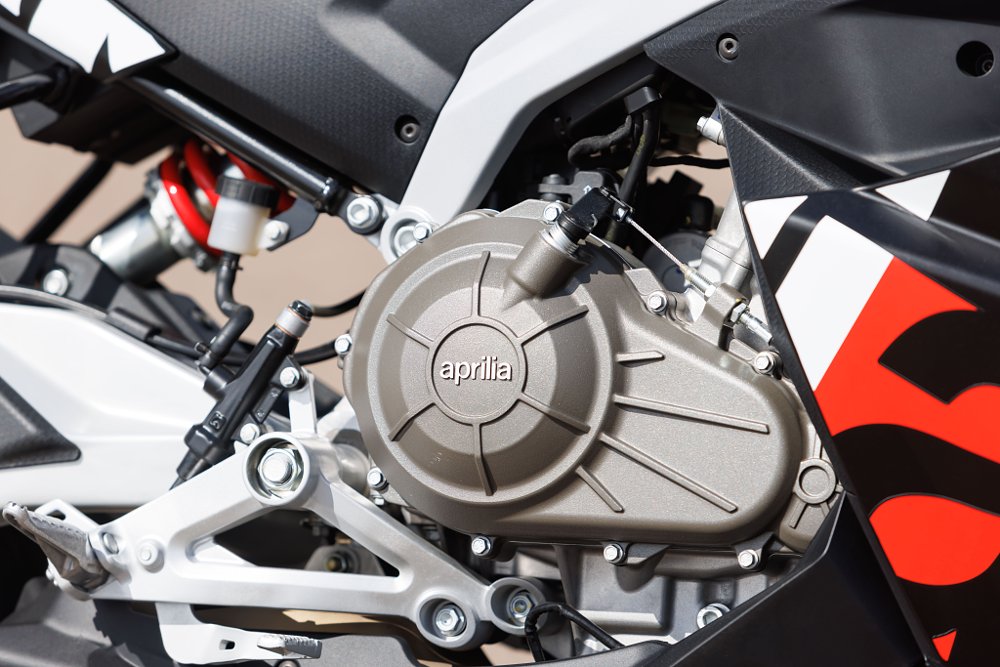
The baby Ape’s 69 mm bore is the smallest of the three but its 61.1 mm stroke is the longest. Unsurprisingly, the 457 produces the least horsepower at 47.6 (at 9,400 rpm) and the most peak torque at 32.1 foot-pounds. What’s more, that peak hits at 6,700 rpm, nearly 1,000 rpm lower than the Ninja and CFMOTO. Aprilia also reports that 82% of the p-twin’s torque is available from as low as 3,000 rpm. I should note that the tach needle rarely fell to those depths on the track.
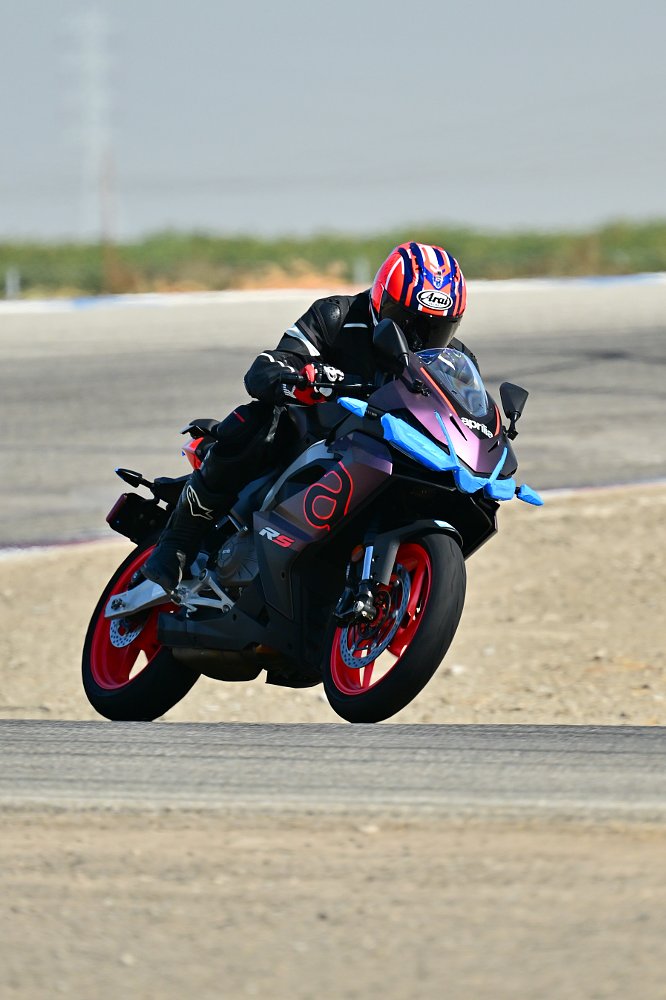
Torque may generously spread across the RS’s rev range, but if you’re trying to maximize drive, you still want to stay in the mid-range. That often required downshifting to the one appropriate gear for each corner. If I missed a downshift, the 457 wouldn’t make up for my lazy footwork. After all, it’s still just a small-bore twin.
Even if it doesn’t have much muscle to flex, the wee Ape never felt gutless. Throttle pickup was direct and responsive, especially since the revs remained above 5,000 rpm while on track. However, I can’t speak to the throttle response in the lower two gears, as I stayed in the top four gears while on the circuit. The only time I clicked into first and second was when entering and exiting the track. To that end, I’ll refer you to Zack’s Daily Rider episode for that feedback. What I can comment on is the engine’s performance in the higher gears, especially when it comes to the upper rev range.
The RS may pull out of the corner with gusto but it runs out of steam as it approaches its 10,700-rpm redline. A fact that was abundantly clear on Buttonwillow’s home straight. Peak horsepower arrives at 9,400 rpm, so I designated 9,000 rpm as my shift point. The only problem is the RS is slow to rev from 7,500 rpm upward, especially in fourth and fifth gears. I felt like a jockey without a whip, willing the tach up to 9,000 rpm with a pinned throttle and wishful thinking. All while supersports and liter bikes roared by. That’s to be expected for a bike of the 457’s size. It may lose ground on the straights but it makes up the time in the curves.
A chassis apart
If steel tubular frames are the rule in the small sport bike segment, the RS 457 is the exception. Aprilia employs an aluminum frame that not only reduces weight but also lends to the model’s compact composition. That’s thanks to the engine functioning as both a stressed member of the frame and the swingarm pivot point, which helps shrink the bike front to back.
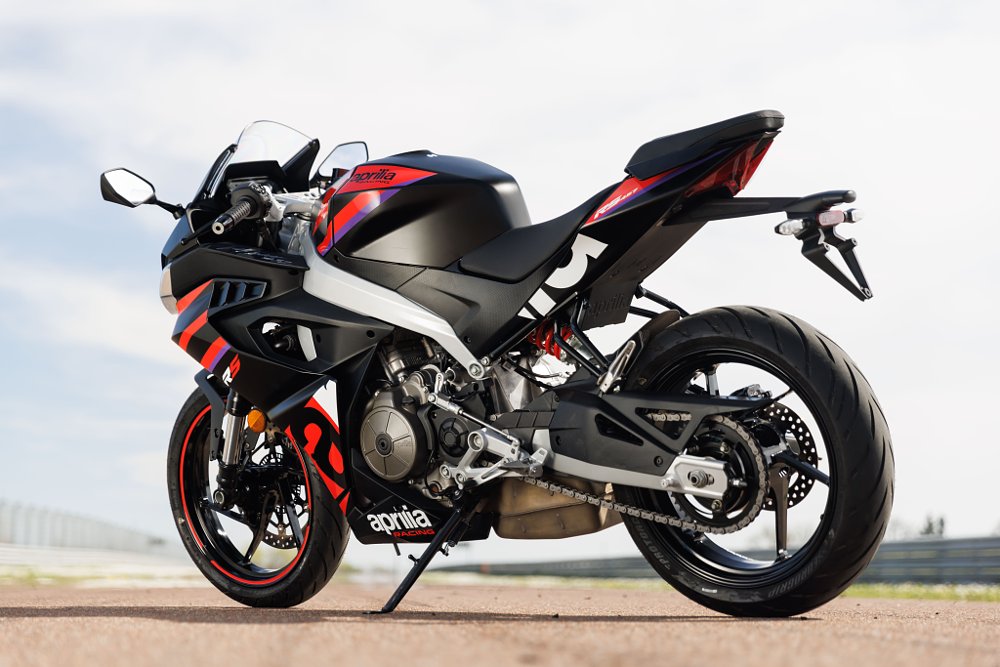
Whereas the 450SS and Ninja 500’s wheelbases hover around 54 inches, the 457’s 53.1-inch wheelbase is closer to the single-powered RC 390 (52.8 inches). The benefits of that short footprint were most pronounced through the Cotton Corner chicane (turn 10), where the RS cut from side to side with rapidity and agility, hugging both curbs while others ran wide.
The same was true at Star Mazda (turn 3) and Off Ramp (turn 11), where running a tighter line allowed the RS to overtake several 600s and 1,000s. I even made up time through the Esses, negotiating the fast bends with a push on the bars here and a tug on the bars there — all with the throttle remaining wide open. Be it acute or obtuse, on-or off-camber, elevated or flat, nearly no section of Buttonwillow foiled the RS’s nimble nature. Nearly.
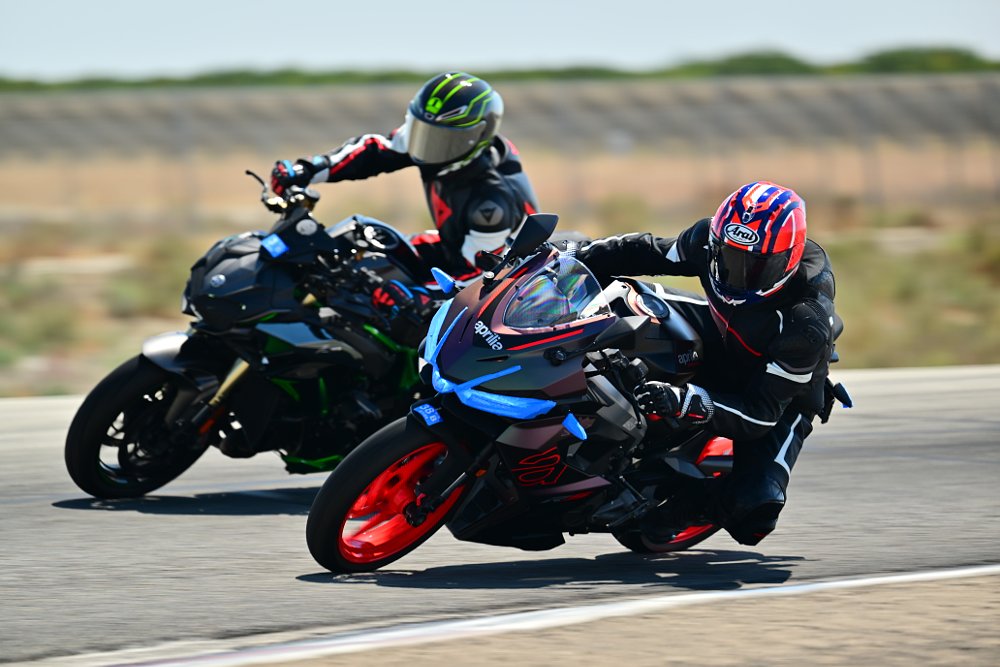
Aprilia flanks its entry-level sport bike with a 41 mm inverted fork and monoshock. That’s standard equipment for the class. Unlike many of its counterparts, the RS 457 isn’t undersprung. Hard braking never overwhelmed the front end. It never wallowed through the turns. Never sunk at corner exit. I was relieved the stock setup was so supportive because it only offers preload adjustability. That’s somewhat limiting, especially when riding on bumpy tarmac.
I’ll be frank, Buttonwillow is due for repaving. At least the section between Star Mazda and Riverside is due for one. The most egregious bumps lie at the two kinks leading to and away from Lost Hill/Phil Hill. I’m often heavy on the gas and fully leaned over through those bends. Add a bump to those two ingredients and you have a recipe for head shake — lots of it.
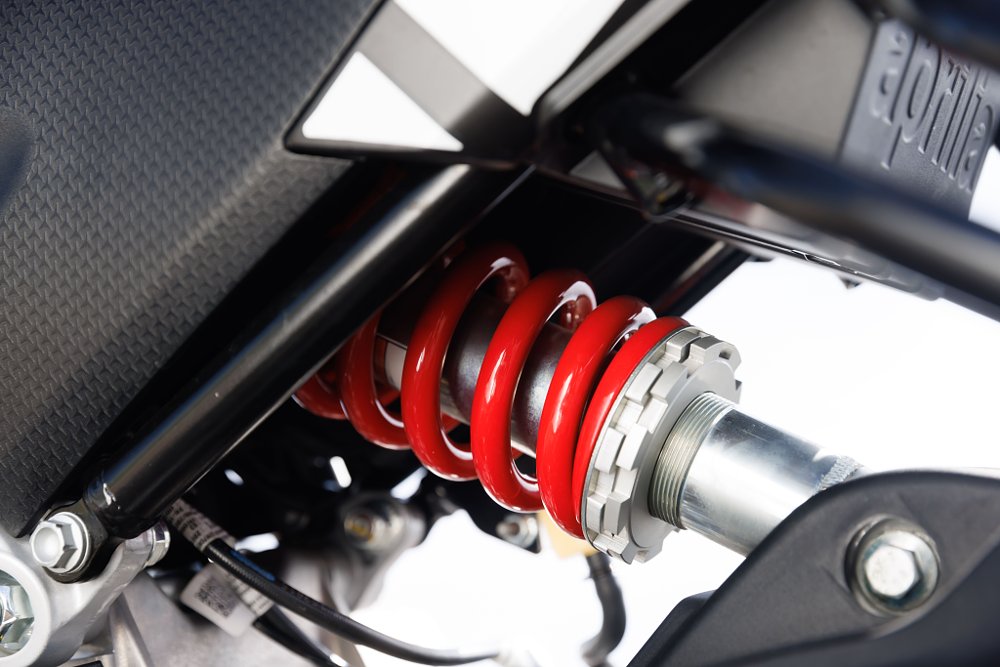
With front and rear preload set to my weight, I had no other choice but to ride around it. I took a different line at one corner and leaned less at another. It’s by no means a dealbreaker, but it is a limitation. I’d only consider upgrading the stock setup if I had intentions of racing the wee Aprilia. The investment isn’t worth the occasional track day. On the other hand, if less-than-ideal tarmac makes up your local track, it’s an option worth considering.
The ByBre braking system doesn’t depart from class conventions either. Its single-disc front setup offers sufficient stopping power for the 386-pound Ape. Vague feedback at the lever is indicative of the axial master cylinder, but around Buttonwillow, I was heavier on the gas than the brakes. To that effect, I never experienced brake fade during any of my track sessions, even when my pace peaked in the afternoon.
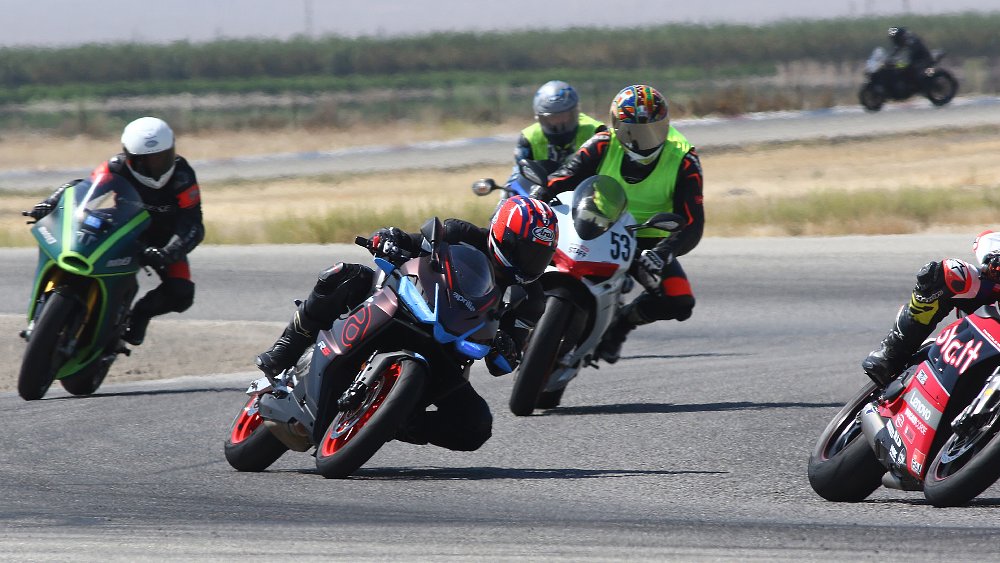
In all, the RS 457’s chassis is the model’s strongest feature. It isn’t perfect, but for a stock setup, it’s impressive. The results aren’t as clear-cut when it comes to the bike’s electronics.
Little luxuries
Just like its bigger brother, the RS 660, the RS 457 comes packed with advanced rider aids. Aprilia stuffs three ride modes (Eco, Sport, and Rain), three-level traction control, and Bosch dual-channel ABS into the model’s electronics suite. The system even allows riders to disengage rear-wheel ABS and disable traction control altogether. Those are nifty tricks for a sport bike of this ilk, but the real question is, does it really need all that tech?
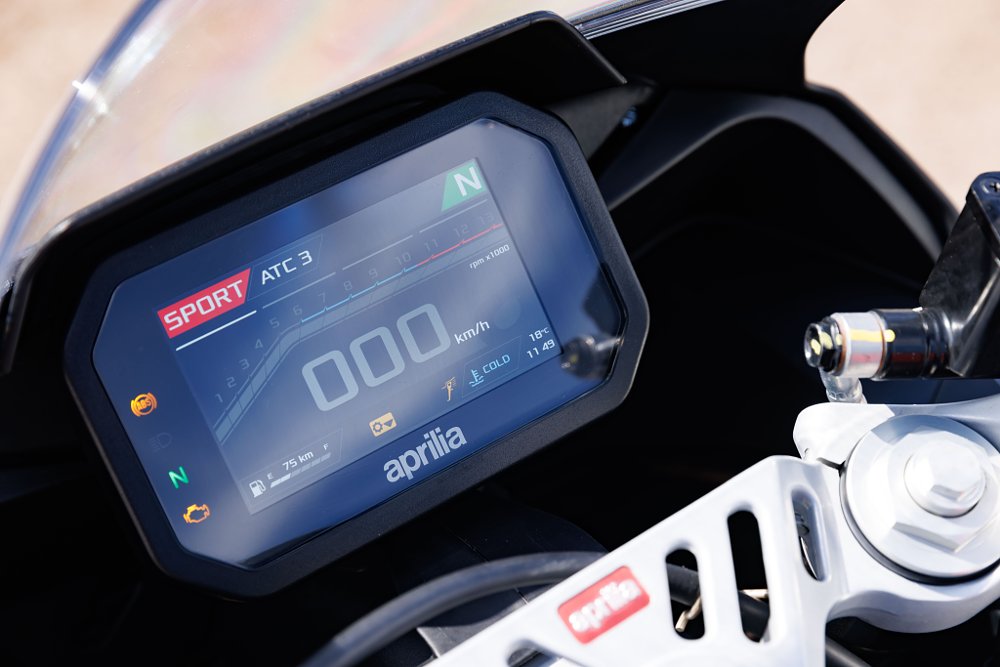
Not once during my seven track sessions did I engage traction control, even with it set for high intervention (ATC 3). I could imagine it coming in handy for beginners, especially since users can set traction control independently of the ride mode. For instance, ATC 3 is the default setting for Rain mode, but it’s an available option in Sport mode too. At the same time, traction control wasn’t necessary during my track-day test. By the last session, I turned it off and was none the worse.
The RS 457’s tech may be sophisticated, but its multi-functional controls are, at times, perplexing. On the home screen, the up and down buttons cycle through the traction control settings. The left and right buttons shuffle across four display layouts. TC is deactivated by long-pressing the down button while accessing the submenus is achieved by holding down the right button. Simple enough, right? Well, here’s where a few hints from Aprilia would help. Disengaging rear ABS requires long-pressing the Mode button (of all buttons). Wondering how to start the lap timer? So was I. Apparently, the high-beam switch does that.
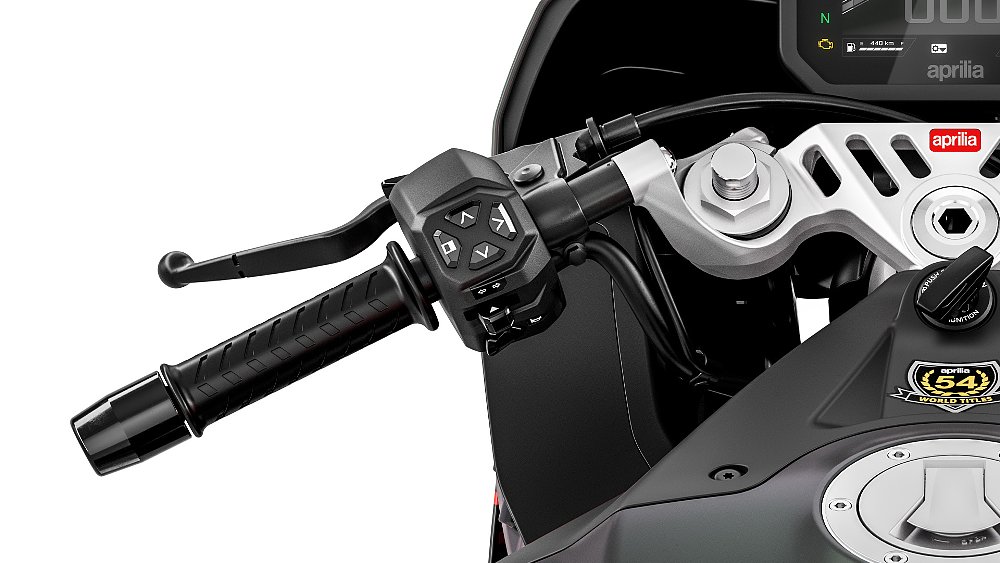
Odds are once you learn these secret handshakes, you’ll remember them, especially if you own the 457 for some time. The problem is that getting to that point is slightly frustrating, as none of those secondary functions are self-explanatory. The submenu controls aren’t much more intuitive. For example, when adjusting the rpm at which the shift light illuminates, the right button climbs through the revs while the left button returns to the main menu. If you miss your intended rpm, which I did, you’re forced to cycle through the whole 11,500-rpm rev range again. You can’t cycle backward. Oy vey. They’re small annoyances, but annoyances nonetheless.
There’s no debating it, the 457’s tech package is advanced for this class. Some will view all that tech as unnecessary. Others will see it as a value prop. Given the RS’s MSRP, Aprilia is banking on customers falling into the latter category.
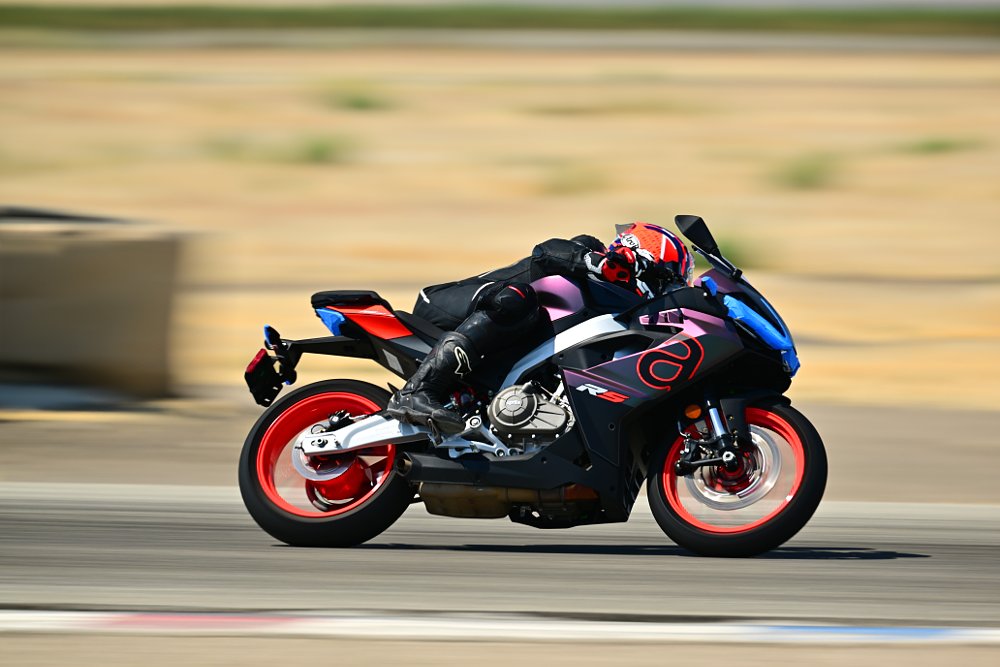
Worth it?
Starting at $6,799, the RS 457 is one of the priciest options in the small sport bike field. Only the CBR500R, at $7,399, is more expensive. (Although, some exclude the Honda from the conversation due to its 471 cc engine.) The 457 is the only model in this category with an aluminum frame. It has one of the most sophisticated tech suites, too. Lest we forget its torquey twin. Aprilia hopes these unique attributes justify the RS’s price tag, but the Noale house should also lean on the things the bike doesn’t need.
Like I said, I’m a cheapskate. If I can avoid buying something, I will. I’d do just that if I owned an RS 457. I’d skip the expensive suspension mods and exhaust upgrades. I’d keep stock controls and fold in the mirrors. I’d simply replace the TVS tires with Pirellis, swap in more aggressive brake pads, and add the model’s optional quickshifter. That’s it. The RS 457 feels native to the track right out of the box. It may cost a pretty penny, but if the occasional track day is a priority, that buy-in price might be worth it.
| 2024 Aprilia RS 457 | |
|---|---|
| Price (MSRP) | $7,295 (as tested); $6,799 (MSRP) |
| Engine | 457 cc, liquid-cooled, eight-valve, parallel twin |
|
Transmission, final drive |
Six-speed, chain |
| Claimed horsepower | 47.6 @ 9,400 rpm |
| Claimed torque | 32.1 foot-pounds @ 6,700 rpm |
| Frame | Aluminum |
| Front suspension | 41 mm fork, adjustable for spring preload; 4.72 inches of travel |
| Rear suspension | Monoshock, adjustable for spring preload; 5.11 inches of travel |
| Front brake | Single ByBre four-piston caliper, 320 mm disc with ABS |
| Rear brake | One-piston caliper, 220 mm disc with switchable ABS |
| Rake, trail | 24.1 degrees, 4.0 inches |
| Wheelbase | 53.1 inches |
| Seat height | 31.4 inches |
| Fuel capacity | 3.4 gallons |
| Tires |
Pirelli Diablo Supercorsa SP V4, 110/70R17 front, 150/60R17 rear (as tested) TVS Eurogrip Protorq Extreme, 110/70R17 front, 150/60R17 rear (stock) |
| Claimed weight | 386 pounds |
| Available | Now |
| Warranty | 24 months |
| More info | aprilia.com |

















